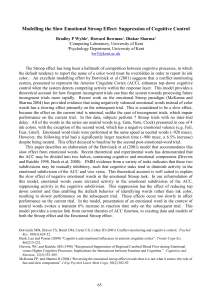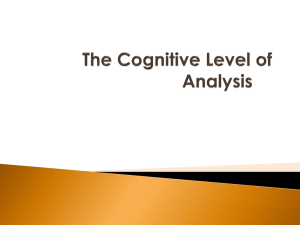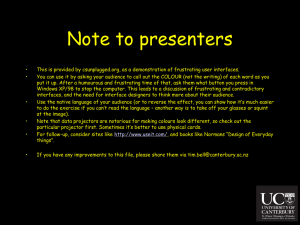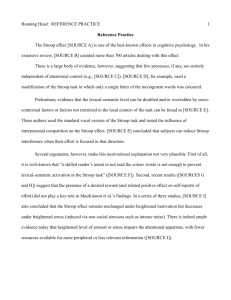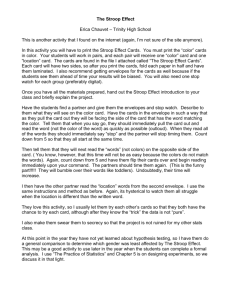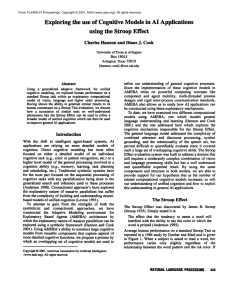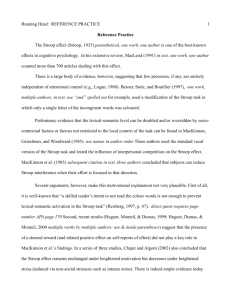The Acute Effectiveness of Exercise on Cognitive
advertisement
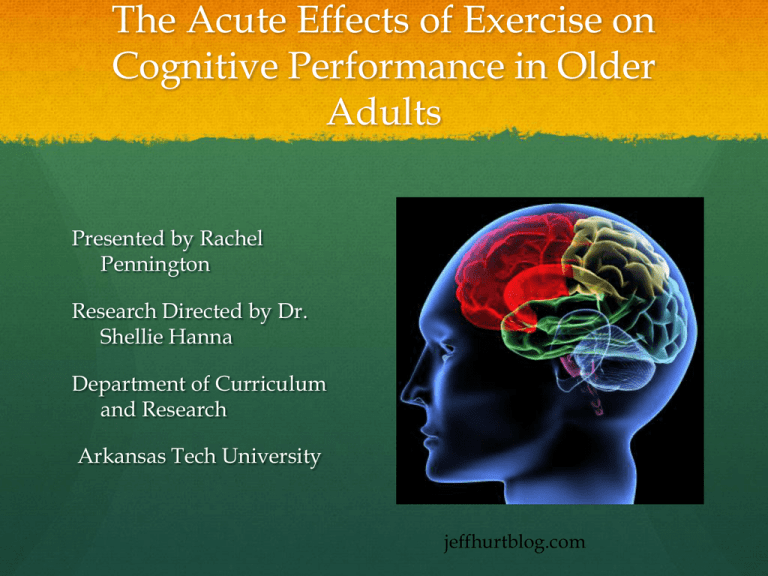
The Acute Effects of Exercise on Cognitive Performance in Older Adults Presented by Rachel Pennington Research Directed by Dr. Shellie Hanna Department of Curriculum and Research Arkansas Tech University jeffhurtblog.com Purpose of Research How can applications of recent neuroscience findings help improve memory retention, mental processing speed, and selective attention in older adults (60+)? Do we have to consistently workout for these results, or can they start happening right away? Exploring the effects of EXERCISE on the BRAIN ebrainsupplements.com Background Information • Past Views • What you were BORN with is all you have– The brain is hardwired. • The brain functions separately from the rest of the body • There isn’t much that you can do to alter damage done to the brain over time Background Information • New Findings • The human brain is much more malleable then we originally thought • New neurons can be developed through neurogenesis • Humans can have significant influence over their brain function • Neuronal networks are continually modified Neuron (cidpusa.org) Background Information • The Long Term Effects of Exercise on the Body • Improved cardiovascular and respiratory Functioning • Reduced coronary artery and disease risk • Prevention/management of high blood pressure, type 2 diabetes, osteoporosis, and certain types of cancer • INCREASED QUALITY OF LIFE If exercise has such positive effects on the body, then is it possible that it has an equally powerful impact on the brain? New neuroscience finding say “yes”! Background Information • The Immediate Effects of Exercise on Cognitive Function • Increase in mental processing speed and selective attention • Mood enhancement • Reduces mental and muscular tension • Increases concentration and memory level “I am convinced that integrating exercise into those eight hours at work or school will not make us smarter. It will only make us normal.” --Dr. John Medina, Brain Rules What We Now Know About the Brain • It is plastic (flexible). • It is an adaptable organ that can be molded much in the same way a muscle can be sculpted by lifting weights. • In order for the brain to be at optimal performance, the body needs to work hard. • The brain is not hardwired, but continually rewired. What We Now Know About The Brain • Exercise improves learning on three levels: • It optimizes your mind-set to improve alertness, attention, and motivation short term and long term. • It prepares nerve cells to bind to one another, which is the cellular basis for logging in new information. • It spurs the development of new nerve cells from stem cells in the hippocampus. Brain Scan Studies Kramer, a neuroscientist at the University of Illinois at Urbana-Champaign (UIUC), studies how fitness training can mold the mind and stave off the effects of aging. Used sedentary test subjects between ages 60-80. Had Subjects undergo aerobic exercise for at least 40 minutes 3 days a week for 6 months. http://scicom.ucsc.edu/publications/ Brain Scan Studies All subjects saw an approximate 15% increase in memory, decision making skills, and selective attention. Kramer took Brain scans of all 60 participants and saw an actual INCREASE in size in the hippocampus, which is the area that’s responsible for memory and decisions. This shows that it is truly a myth that older brains MUST decrease in plasticity as they age, it can be prevented easily! Brain Scan Studies Exercise helps maintain and even build brain plasticity (strength in-between neurons that reinforce brain connections), stopping, and even REVERSING memory loss. Exercise causes more blood flow to the brain, enhancing energy production and waste removal. The brain scans also show that in response to exercise, cerebral blood vessels can grow. Extending the Research to the Local Setting Hypothesis My hypothesis is that the memory retention, mental processing speed, and selective attention would acutely improve in the participants after they had exercised in comparison to their memory retention, mental processing speed, and selective attention prior to exercise A second purpose of my research is to prove that positive cognitive effects can start taking place right away, encouraging older adults to get active and prolong the amount of time they have leading a good quality of life. Methods Arkansas Tech University’s institutional review board reviewed and approved all protocol and procedures pertaining this study. 30 adults (13 men, 18 women; M age =67.8) volunteered. Class choices included Pilates or Muscular Strength & Range Of Motion (MSROM Silver Sneakers) 9 participants chose Pilates (4 male, 5 female, M age=62.7) and 21 chose MSROM (9 male, 12 female, M age = 70.39) Methods: The Stroop Test This is widely used and accepted assessment tool for testing cognitive quickness and executive function (Levine, Stuss, and Milberg 1995) I used this because it places demands on cognitive flexibility by requiring shifting of perceptual set in accordance with changing external demands, as well as the inhibition of a habitual response in favor of a novel one. Methods: The Stroop Test (Sharp Brains 2011) ) Methods: The Stroop Test The Stroop test used (Neuroscience for Kids 2011) was created by the Center for Sensorimotor Neural Engineering in Seattle, Washington, and can be accessed an taken at http://faculty.washington.edu/chudler/words.htm l Results are reliable and valid when tested online (Campbell et al. 1999) Methods: Ratings of Percieved Exertion Maintaining a moderate intensity level is key. Detrimental effects from fatigue could mask the benefits of exercise on performance (Tomporowski 2003; Tomporowski and Ellis 1986) Participants exercised at a self determined moderate intensity level using the Borg scale of Perceived Exertion (RPE) Methods: Borgs RPE scale This scale has been shown to be psychometrically sound, with reliability coefficients above .90 and validity coefficients at .77 and higher (Borg 1998). RPE measures were taken every 10 min throughout the exercise protocol. Participants stayed within the parameter of 13-15 Methods: Exercise Protocol When compared by a OneWay ANOVA test, these two classes were determined to have no differences from each other. Methods: Exercise Protocol Silver Sneakers Pilates • 5 minute warm-up with stretching. 5 minute warm-up with stretch • Equipment used: 2-3 lb weights, resistance band with handles Equipment used: floor mat • Followed an instructor for 40 minutes • 5 minute cool down period Followed an instructor for 40 minutes 5 minute cool down period Methods: Procedure Each Participant took the Stroop Test prior to exercise, and the response time was recorded on a computerized program Participants exercised for 50 total minutes, RPE was monitored every 10 minutes Participants rested quietly for 30 minutes, them completed the Stroop test post-exercise and the response time was recorded via computer program. Methods: Analysis Three separate analyses were performed: 1. One way ANOVA 2. Descriptive Statistics 3. Paired Samples TTests RESULTS: Table 1. One-Way ANOVA Showing the Comparison Between Pilates and SilverSneakers MSROM Sum of df Squares Mean F Square Sig. Before Exercise: Between Groups: 15.629 1 Within Groups: 1089.770 28 Total : 1105.398 29 After Exercise: 15.629 38.920 0.40 0.53 2 1 Between Groups Within Groups Total 9.046 34.750 0.26 0.61 0 4 9.046 973.000 982.046 1 28 29 Results Table 2. Total Mean Test Scores Showing the Difference in Testing Results Before and After Exercise Before Exercise After Exercise Mean 20.33297 16.31967 N 30 30 Std. Deviation 6.173912 5.819248 Table 3. Paired Samples Test Showing Paired Differences Paired Differences Mean Test BeforeTest After 4.013300 Std. Deviation 3.074691 Std. Error Mean 0.561359 Results Table 4. Paired Samples Correlation Test Showing the Relationship Between Exercise and Cognitive Function N Test 30 Before and After Correlation Sig. 0.870 0.000 Table 5. Paired Samples Test Showing the Confidence Interval of the Difference Paired Differences 95% Confidence Interval of the Difference Lower Upper T Test 2.8651 5.1614 7.149 Before 92 08 - Test After Df 29 Sig. (2tailed) 0.000 Conclusions/Discussion MY HYPOTHEIS WAS SUPPORTED Both exercise groups completed the post-exercise test faster than the pre-exercise test Out of the 30 test subjects, none failed to improve their test scores post-exercise. There was such a difference in test scores that the level of significance was p=0.000, which is the ideal statistical condition. Conclusions/Discussion The increase in cognitive ability was shown to be beyond a doubt due to the physiological effects caused by the exercise protocol. These positive results are very encouraging, and prove that there is a safe and healthy way to improve cognitive function. The results also show that the benefits of exercise start taking place right away, and improve function immediately. Discussions/Conclusion Improvement in Data Collection Other processes related to physiological arousal such as the increase in catecholamines of neurotrophins may also drive improvements in cognitive performance, and were not directly evaluated in this study No physical fitness test was used to set and monitor exercise intensity, RPE’s were self monitored Like to have a larger number of participants MAIN GOALS: Continuing the efforts of this research and spreading the word about neuroscience findings! HOW DO WE GET EDUCATORS, STUDENTS, PARENTS, ETC ON BOARD? References Borg, G.V. 1998. Borg’s Perceived Exertion and Pain Scales. Illinois: Human Kinetics. Levine, B., Stuss, D.T., & Milberg, W.P. 1995. “Concept Generation; Validation of a Test of Executive Functioning in a Normal Aging Population. “ Journal of Clinical and Experimental Neuropsychology 17: 740-58. Sharp Brains. 2011. “Physical Exercise: Why Aerobic Exercise Enhances Neurogenesis and Neuroplasticity”. Accessed October 22. http://www.sharpbrains.com/resources/2-the-4-pillarsof-brain-maintenance/physical-exercise-why-aerobicexercise-enhances-neurogenesis-and-neuroplasticity/ •Campbell, Keith A., Rohlman, Diane S., Storzback, Daniel., Binder, Laurence M., Anger, Kent W., Kovera, Craing A., Davis, Kelly L., Grossmann, Sandra J. 1999. “The reliability of computerized testing. “Test Retest Reliability of Psychological and Neurobehavioral Tests Self-Administered by Computer Assessment 6: 21-32 •Tomporowski, P.D. 2003. “Effects of Acute bouts of Exercise on Cognition.” Acta Psychologica 112: 297-324 •Tomporowski, P.D., Ellis, N.R. 1986. “Effects of Exercise on Cognitive Processes; A Review. Psychological Bulletin 99: 338-46.

